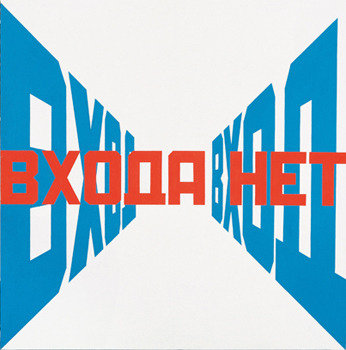Erik Bulatov
dal 27/6/2013 al 28/9/2013
Segnalato da
NMNM Nouveau Musee National de Monaco
27/6/2013
Erik Bulatov
NMNM Nouveau Musee National de Monaco, Monaco
Paintings and Drawings 1966-2013. The exhibition consists of 30 large paintings and about 40 drawings in correspondence with drawings by Ed Ruscha. The use of text is a recurrent element in the pictorial compositions of both artists.

Nouveau Musée National de Monaco presents a retrospective selection of Erik Bulatov's work with paintings and drawings dating from 1966 to the present on the eve of the artist's 80th birthday, curated by Marie-Claude Beaud, Director and Cristiano Raimondi, Head of Development and International Projects at NMNM.
The exhibition will be held at Villa Paloma from 28 June to 29 September 2013. It will consist of 30 large paintings and about 40 drawings.
Erik Bulatov was born in 1933 in Sverdlovsk, Russia. He lives and works in Paris. His first major exhibition was held in 1988 at Kunsthalle Zurich and Centre Pompidou. After that, Bulatov has had numerous monographic exhibitions, at Musée Maillol, Paris (1999), Tretyakov-Gallery, Moscow (2003 and 2006) Kestnergesellschaft, Hanover (2006), Musée d'Art Moderne de la Ville de Paris (2007) and MAMCO - Museum of Modern and Contemporary Art in Geneva (2009/2010).
The theme of freedom is a central one in the creative and personal evolution of Erik Bulatov. Indeed, even before studying at the Painting Faculty of the Moscow Artistic Institute, the artist was aware of the falsity of the art being taught there, and the means for its formal and ideological expression. After graduation, Erik Bulatov developed his own conception of life in such a way as not to depend on the state in his professional work. In the course of thirty years, Bulatov illustrated children's books, and engaged with his art—what he calls 'my fundamental cause'—unofficially, with no possibility of exhibiting his works. The path he chose did not portend success and recognition. One should not underestimate the threat of persecution, which was a permanent feature of his life and which was very real. It seemed that the Soviet system was indestructible and would last forever. Therefore an escape was a formal independence from the state: 'To draw without permission was where our freedom lay.'
The question of personal freedom is the fundamental concept in Bulatov's art, one that is not connected to social criticism. The artist introduces the term of 'social space,' in other words, the space of our life that depends on society, the state and our whole environment. At the same time, it is not only the Soviet space that is in the artist's opinion unfree, but every other space, too—though this has its boundary. 'Human freedom and generally the meaning of existence are situated on the other side of that boundary, in the space of art.'
In the frame of the Erik Bulatov exhibition, the NMNM has chosen to put the works of Erik Bulatov in correspondence with drawings by Ed Ruscha. The use of text—its typographical quality, its representation in perspective and its positioning in the foreground of the image—is a recurrent element in the pictorial compositions of both artists. The "image-text" is formed by words that exist simultaneously as linguistic and visual signs. The painting is read through the text, which determines or inflects its meaning. In the history of art in the second half of the twentieth century, these two artists, despite seeming diametrically opposed to each other—Ruscha's work belonging to the history of the West, Bulatov to that of the East—have opened figurative painting to the visual and semantic poetry of words by combining the two in an immediately recognisable manner.
Their respective works originate first and foremost in the history of modernity and its expression in the urban development of cities, their architecture and the visual propaganda or advertisements that progressively invaded them. Both painters have opted for a rather neutral, not to say cool, finish and value the potential of the image over painting as such. The NMNM will therefore explore links between Erik Bulatov and Ed Ruscha. To this end, La Table des Matières—the public and education space located on the ground floor of Villa Paloma—will present a selection of drawings, from the UBS Art Collection, made by Ruscha between 1960 and 1970.
Image: Erik Bulatov, "Entrance – No Entrance," 1974–75. Oil on canvas, 180 x 180 cm. Collection Centre Pompidou, Paris.
Opening: 28 June 2013
NMNM Nouveau Musee National de Monaco
56, boulevard du Jardin Exotique, 98000 Monaco (Villa Paloma), Monaco
Opening Hours:
Open every day from 8am until 6pm
11am until 7pm from June 1st until September 30th
Closed on January 1st, May 1st, 4 days of the Grand Prix, November 19th and December 25th
Entrance rates:
Full price NMNM ticket (Villa Paloma + Villa Sauber) 6€
Groups 4€ (min. 15 people)
Combined ticket NMNM / Exotic Garden / Anthropological Museum: 10€
Free entrance the first Sunday of each month
Free for anyone under 26 years old, scholar groups and groups of children, Monégasque citizens, members of the Association des Amis du NMNM, ICOM and CIMAM members, job seekers upon presentation of documentary evidence, disabled



